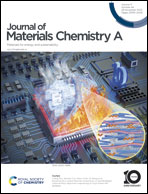Emerging disorder in Gd2(Ti1−xZrx)2O7 pyrochlores matrices for radioactive waste disposal: symmetry lowering versus defect clustering†
Abstract
Pyrochlore compositions in the Gd2(Ti1−xZrx)2O7 solid solution have gained attention in the field of radioactive waste forms because they are capable of withstanding high doses of ion irradiation without becoming amorphous, as the Zr-content increases. The purpose of this study was to explore the structure of Gd2(Ti1−xZrx)2O7 compounds at various length scales using Synchrotron High-Resolution X-ray Powder Diffraction (HR-XRPD), Pair Distribution Function (PDF) analysis, and Raman spectroscopy. Through Rietveld analysis of HR-XRPD patterns, it was determined that substituting Ti with Zr in the Gd2Ti2O7 compound results in the gradual formation of Anti-Frenkel (AFr) Oxygen defects and, for xZr ≥ 0.75, in slight cation A/B site disordering, while still maintaining the same average pyrochlore structure. Raman spectroscopy shows a marked change in the spectra for xZr ≥ 0.50, with a general broadening of the bands and the emergence of new spectral features, indicating an increase in static disorder and some symmetry breaks at shorter length scales. This outcome was confirmed by PDF modelling in the low r region. Two alternative models were proposed to map the disorder: (i) a Pmma weberite-type structure, which suitable fits the PDFs in the Zr-rich part of the phase diagram only up to r ≈ 8 Å; (ii) a disordered pyrochlore structure containing Anti-Frenkel (AFr) pairs in the form of extended clusters as generated by DFT calculations. The short r range of applicability of the weberite-type model and the computed energy values tip the balance in favor of the AFr clusters.



 Please wait while we load your content...
Please wait while we load your content...